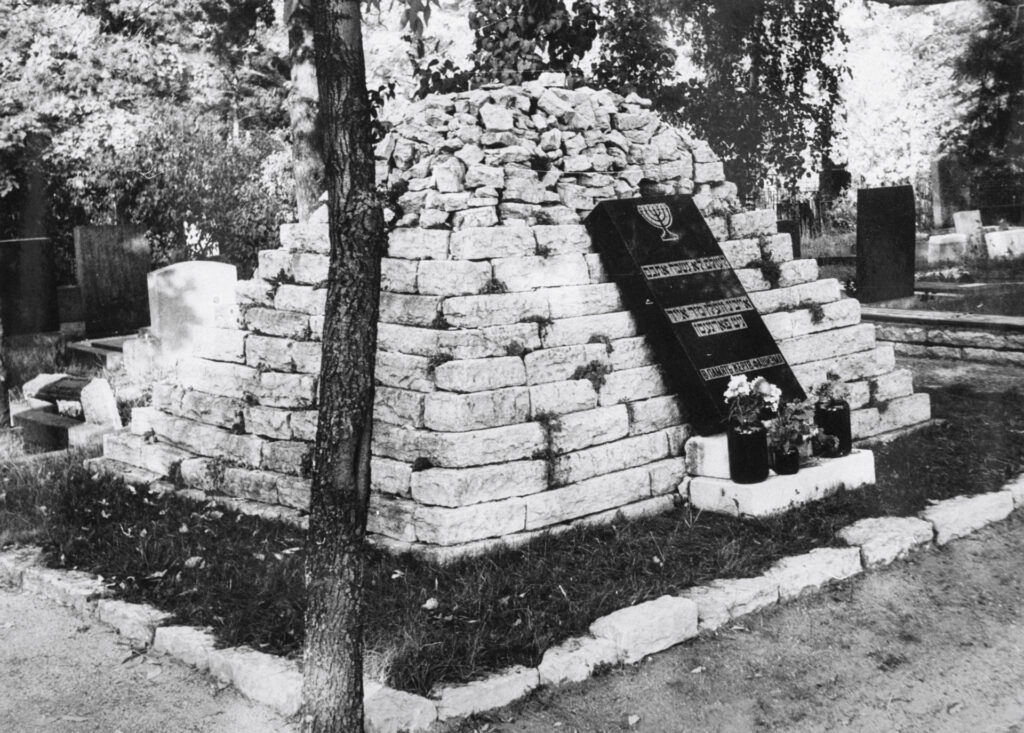Most of the 1,000 Jews that remained in Estonia still lived in Tallinn during the beginning of the German occupation; some also lived in Tartu and Pärnu. Apart from a few exceptions, most of them were arrested and executed within the next six months (by January 1942). It is not possible to determine the exact number of executed persons.
The names of more than 900 Estonian Jews executed in German occupied Estonia are known. More than 500 of them were from Tallinn, over 150 from Tartu, and over 130 from Pärnu. Very little information has preserved concerning the exact circumstances of the executions.
In Lithuania and Latvia, the German SS operative groups (Einsatzgruppe) attempted to organise local anti-Jewish pogroms and mass executions of Jews using Judeo–Bolshevism propaganda with varying degrees of success. According to SS-Brigadeführer Franz Walter Stahlecker, commander of operative group A that oversaw this region, it was essential to create an impression that the reckoning with Bolsheviks and Jews takes place on local initiative, and without the German authorities’ direction.
In Estonia, a different situation developed. The operative group’s report concluded that attempts to organise pogrommes in Estonia were unsuccessful. It was assumed that this was due to insufficient propaganda. According to SS-Sturmbannführer Martin Sandberger, the commander of the German Security Police (Sicherheitspolizei) and SD in Estonia who operated here directly, refraining from pogrommes in Estonia was part of his intentional policy.
The elimination of Estonian Jews can be chronologically divided into two stages. During the first stage, starting from mid-July 1941, a general system for the arrest of all Jews was not yet in place. Jews were arrested along with other local residents during general rear area security operations, after the region had fallen under Wehrmacht’s control.
Such activities took place on the orders of German military authorities. The direct enforcers of arrests and later, executions, were mostly Estonian Forest Brothers, members of the Home Guard or appointed policemen. Jews that were among the arrested were separated from the rest. All of them, without exception, faced execution. There was no exact procedure in place yet for sentencing death penalties. Sentencing a death penalty was formally put on the shoulders of Estonian officials, whose decisions had to be verified by the local German field command or the local SS operative group special command 1a (Sonderkommando).
The systematic implementation of German anti-Jewish policy in Estonia began during the second stage that started on 10 September 1941. Everything related to Jews was gathered in the hands of the SS special command. After 5 December 1941, the SS special command was reorganised into the German Security Police and the SD in Estonia. The new system did not order the immediate deportation of all Jews. “Traditional” restrictions were implemented first, such as forbidding the use of public transport and buildings, requiring the Jews wear a Yellow Star as a means of identification, confiscation of possessions, etc. Sandberger, the commander of the special command 1a, tried to show the “peace-making” process as an entirely legal activity. He started a bureocratic procedure that was meant to legalise anti-Jewish actions in the eyes of local residents. Public violence and the mass murder of helpless women and children would have resulted in the public’s immediate loss of trust for the German occupying regime, as people had only recently escaped Soviet terror. The new priority was the compilation of a complete list of Jews. The tasks of the Political Police, formed of Estonians, were the arrests, formal investigations and drafting the decision proposals. All this was to be confirmed by the German Security Police. Often, it sufficed if the accusation was merely based on the persons’ ethnic background (“Jew”). Arrested Jewish men were detained in Patarei; women and children were taken to the Harku camp near Tallinn.
The executions were most likely carried out by a special command formed of Estonians based on lists compiled by the German Security Police. The general responsibility for the murders lies with the local German military authorities and the leaders of special command 1a (Martin Sandberger). The responsibility for the activities of the so-called Estonian Political Police primarily lies with its leader Roland Lepik, as well as head of the special command Aleksander Koolmeister and Luha (first name unidentified).

(National Archives of Estonia)
Minimal firsthand data has preserved about the direct extermination of Estonian Jews. The last of them, the Jewish women and children from Tallinn, were most likely executed in January 1942 at the latest. On 20 January, Estonian territory was declared a Judenfrei area at the Wannsee conference in Germany. According to the Estonian Jewish community’s data, only eight Jews survived the German occupation in their homeland.